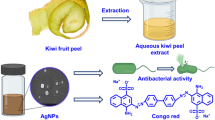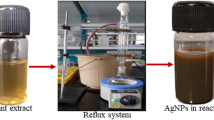Abstract
Green chemistry offers several benefits over other synthesis routes of nanoparticles due to their eco-friendly attributes during their formulation as well as application stages. In the present study, an aqueous extract of Ananas comosus (Pineapple) peel waste was successfully exploited for the synthesis of ultra small (average size 14–20 nm) silver nanoparticles (AgNPs) without adding any reducing or stabilizing agents. Two major factors, i.e., concentration ratio between silver ion precursor versus peel extract and synthesis pH were found to be influential for achieving monodispersed and stable AgNPs. Biogenic AgNPs adorned with natural moieties demonstrated good photocatalytic activity against methylene blue (MB) dye under sunlight illumination for various conditions. The process variable, e.g., solution pH, initial MB concentration and contact time were optimized using response surface methodology (RSM) based on three levels Box-Behnken design. A maximum MB removal of 98.04% was achieved at optimized values of 9.96 pH, 40 ppm initial dye concentration and 173 min of contact time. The kinetics of MB removal was best fitted to its first order kinetic model (R2 = 0.996) in concurrence with intraparticle diffusion-mediated adsorption. AgNPs were also found to be effective to kill pathogenic bacterial strains, Pseudomonas aeruginosa and Bacillus subtilis as characterized from zone of inhibition (ZoI) and viability tests. Undergoing photochemical reactions, the generation of reactive oxygen species (ROS) was elucidated as the major mechanism of AgNPs’ toxicity modulating membrane permeability. This strategy is not only economically viable and environmentally benign, synthesized AgNPs were capable to remove methylene blue dye almost completely under ambient conditions through solar energy.







Similar content being viewed by others
References
Agnihotri S, Dhiman NK (2017) Development of nano-antimicrobial biomaterials for biomedical applications. In: Tripathi A, Melo JS (eds) Advances in biomaterials for biomedical applications. Springer, Singapore, pp 479–545. https://doi.org/10.1007/978-981-10-3328-5_12
Agnihotri S, Mukherji S, Mukherji S (2012) Antimicrobial chitosan–PVA hydrogel as a nanoreactor and immobilizing matrix for silver nanoparticles. Appl Nanosci 2(3):179–188
Agnihotri S, Mukherji S, Mukherji S (2013) Immobilized silver nanoparticles enhance contact killing and show highest efficacy: elucidation of the mechanism of bactericidal action of silver. Nanoscale 5(16):7328–7340. https://doi.org/10.1039/C3nr00024a
Agnihotri S, Mukherji S, Mukherji S (2014) Size-controlled silver nanoparticles synthesized over the range 5–100 nm using the same protocol and their antibacterial efficacy. RSC Adv 4(8):3974–3983
Agnihotri S, Bajaj G, Mukherji S, Mukherji S (2015) Arginine-assisted immobilization of silver nanoparticles on ZnO nanorods: an enhanced and reusable antibacterial substrate without human cell cytotoxicity. Nanoscale 7(16):7415–7429
Agnihotri S, Dhiman NK, Tripathi A (2018) Antimicrobial surface modification of polymeric biomaterials In: Tiwari A (ed) Handbook of antimicrobial coatings. Elsevier, New York, pp 435–486. https://doi.org/10.1016/B978-0-12-811982-2.00020-2
Akerdi AG, Bahrami SH, Arami M, Pajootan E (2016) Photocatalytic discoloration of Acid Red 14 aqueous solution using titania nanoparticles immobilized on graphene oxide fabricated plate. Chemosphere 159:293–299
Akhtar MS, Panwar J, Yun Y-S (2013) Biogenic synthesis of metallic nanoparticles by plant extracts. ACS Sustain Chem Eng 1(6):591–602. https://doi.org/10.1021/sc300118u
Awazu K, Fujimaki M, Rockstuhl C, Tominaga J, Murakami H, Ohki Y, Yoshida N, Watanabe T (2008) A plasmonic photocatalyst consisting of silver nanoparticles embedded in titanium dioxide. J Am Chem Soc 130(5):1676–1680. https://doi.org/10.1021/ja076503n
Ayad MM, El-Nasr AA (2010) Adsorption of cationic dye (Methylene blue) from water using polyaniline nanotubes base. J Phys Chem C 114(34):14377–14383. https://doi.org/10.1021/jp103780w
Bharti S, Agnihotri S, Mukherji S, Mukherji S (2015) Effectiveness of immobilized silver nanoparticles in inactivation of pathogenic bacteria. J Environ Res Dev 9(3A):849–856
Forgacs E, Cserhati T, Oros G (2004) Removal of synthetic dyes from wastewaters: a review. Environ Int 30(7):953–971
Ginimuge PR, Jyothi SD (2010) Methylene blue: revisited. J Anaesthesiol Clin Pharmacol 26(4):517–520
Hai FI, Yamamoto K, Fukushi K (2007) Hybrid treatment systems for dye wastewater. Crit Rev Environ Sci Technol 37(4):315–377
Hao OJ, Kim H, Chiang P-C (2000) Decolorization of wastewater. Crit Rev Environ Sci Technol 30(4):449–505. https://doi.org/10.1080/10643380091184237
He S, Yao J, Jiang P, Shi D, Zhang H, Xie S, Pang S, Gao H (2001) Formation of silver nanoparticles and self-assembled two-dimensional ordered superlattice. Langmuir 17(5):1571–1575
Hogan NJ, Urban AS, Ayala-Orozco C, Pimpinelli A, Nordlander P, Halas NJ (2014) Nanoparticles heat through light localization. Nano Lett 14(8):4640–4645
Hossain MA, Rahman SM (2011) Total phenolics, flavonoids and antioxidant activity of tropical fruit pineapple. Food Res Int 44(3):672–676
Kasuya A, Sivamohan R, Barnakov YA, Dmitruk IM, Nirasawa T, Romanyuk VR, Kumar V, Mamykin SV, Tohji K, Jeyadevan B (2004) Ultra-stable nanoparticles of CdSe revealed from mass spectrometry. Nat Mater 3(2):99
Khan S, Malik A (2018) Toxicity evaluation of textile effluents and role of native soil bacterium in biodegradation of a textile dye. Environ Sci Pollut Res 25(5):4446–4458. https://doi.org/10.1007/s11356-017-0783-7
Kora AJ, Beedu SR, Jayaraman A (2012) Size-controlled green synthesis of silver nanoparticles mediated by gum ghatti (Anogeissus latifolia) and its biological activity. Org Med Chem Lett 2:17–17. https://doi.org/10.1186/2191-2858-2-17
Koyani RD, Sanghvi GV, Sharma RK, Rajput KS (2013) Contribution of lignin degrading enzymes in decolourisation and degradation of reactive textile dyes. Int Biodeterior Biodegrad 77:1–9
Lee KJ, Jun BH, Choi J, Lee YI, Joung J, Oh YS (2007) Environmentally friendly synthesis of organic-soluble silver nanoparticles for printed electronics. Nanotechnology 18(33):335601
Leng K, Mai W, Zhang X, Liu R, Lin X, Huang J, Lou H, Xie Y, Fu R, Wu D (2018) Construction of functional nanonetwork-structured carbon nitride with Au nanoparticle yolks for highly efficient photocatalytic applications. Chem Commun 54:7159–7162. https://doi.org/10.1039/C8CC03095B
Li Y, Zhang W, Niu J, Chen Y (2012) Mechanism of photogenerated reactive oxygen species and correlation with the antibacterial properties of engineered metal-oxide nanoparticles. ACS Nano 6(6):5164–5173
Li X, Jin X, Zhao N, Angelidaki I, Zhang Y (2017) Novel bio-electro-Fenton technology for azo dye wastewater treatment using microbial reverse-electrodialysis electrolysis cell. Bioresour Technol 228:322–329. https://doi.org/10.1016/j.biortech.2016.12.114
Lin X, Liang Y, Lu Z, Lou H, Zhang X, Liu S, Zheng B, Liu R, Fu R, Wu D (2017) Mechanochemistry: a green, activation-free and top-down strategy to high-surface-area carbon materials. ACS Sustain Chem Eng 5(10):8535–8540
Lokesh K, Sivakiran R (2014) Biological methods of dye removal from textile effluents—a review. J Biochem Technol 3(5):177–180
Mittal AK, Chisti Y, Banerjee UC (2013) Synthesis of metallic nanoparticles using plant extracts. Biotechnol Adv 31(2):346–356. https://doi.org/10.1016/j.biotechadv.2013.01.003
Mukherjee P, Ahmad A, Mandal D, Senapati S, Sainkar SR, Khan MI, Parishcha R, Ajaykumar P, Alam M, Kumar R (2001) Fungus-mediated synthesis of silver nanoparticles and their immobilization in the mycelial matrix: a novel biological approach to nanoparticle synthesis. Nano Lett 1(10):515–519
Mukherjee P, Roy M, Mandal B, Dey G, Mukherjee P, Ghatak J, Tyagi A, Kale S (2008) Green synthesis of highly stabilized nanocrystalline silver particles by a non-pathogenic and agriculturally important fungus T. asperellum. Nanotechnology 19(7):075103
Mukherji S, Ruparelia J, Agnihotri S (2012) Antimicrobial activity of silver and copper nanoparticles: variation in sensitivity across various strains of bacteria and fungi. In: Cioffi N, Rai M (eds) Nano-antimicrobials: progress and prospects. Springer-Verlag, Berlin Heidelberg, pp 225–251
Nadagouda MN, Iyanna N, Lalley J, Han C, Dionysiou DD, Varma RS (2014) Synthesis of silver and gold nanoparticles using antioxidants from blackberry, blueberry, pomegranate, and turmeric extracts. ACS Sustain Chem Eng 2(7):1717–1723. https://doi.org/10.1021/sc500237k
Peng S, McMahon JM, Schatz GC, Gray SK, Sun Y (2010) Reversing the size-dependence of surface plasmon resonances. Proc Natl Acad Sci USA 107(33):14530–14534. https://doi.org/10.1073/pnas.1007524107
Peretyazhko TS, Zhang Q, Colvin VL (2014) Size-controlled dissolution of silver nanoparticles at neutral and acidic pH conditions: kinetics and size changes. Environ Sci Technol 48(20):11954–11961. https://doi.org/10.1021/es5023202
Raveendran P, Fu J, Wallen SL (2003) Completely “green” synthesis and stabilization of metal nanoparticles. J Am Chem Soc 125(46):13940–13941
Rivas Aiello MB, Romero JJ, Bertolotti SG, Gonzalez MnC, Mártire DO (2016) Effect of silver nanoparticles on the photophysics of riboflavin: consequences on the ROS generation. J Phys Chem C 120(38):21967–21975. https://doi.org/10.1021/acs.jpcc.6b06385
Robinson T, McMullan G, Marchant R, Nigam P (2001) Remediation of dyes in textile effluent: a critical review on current treatment technologies with a proposed alternative. Bioresour Technol 77(3):247–255
Sahoo C, Gupta AK (2012) Optimization of photocatalytic degradation of methyl blue using silver ion doped titanium dioxide by combination of experimental design and response surface approach. J Hazard Mater 215–216:302–310. https://doi.org/10.1016/j.jhazmat.2012.02.072
Saraswaty V, Risdian C, Primadona I, Andriyani R, Andayani DGS, Mozef T (2017) Pineapple peel wastes as a potential source of antioxidant compounds. IOP Conf Ser Earth Environ Sci 60(1):012013
Saratale RG, Karuppusamy I, Saratale GD, Pugazhendhi A, Kumar G, Park Y, Ghodake GS, Bhargava RN, Banu JR, Shin HS (2018) A comprehensive review on green nanomaterials using biological systems: recent perception and their future applications. Colloids Surf B Biointerfaces 170(1):20–35. https://doi.org/10.1016/j.colsurfb.2018.05.045
Shanker U, Rani M, Jassal V (2017) Degradation of hazardous organic dyes in water by nanomaterials. Environ Chem Lett 15(4):623–642. https://doi.org/10.1007/s10311-017-0650-2
Sharma VK, Yngard RA, Lin Y (2009) Silver nanoparticles: green synthesis and their antimicrobial activities. Adv Colloid Interf 145(1–2):83–96
Sharma VK, Filip J, Zboril R, Varma RS (2015) Natural inorganic nanoparticles—formation, fate, and toxicity in the environment. Chem Soc Rev 44(23):8410–8423. https://doi.org/10.1039/C5CS00236B
Tayade RJ, Natarajan TS, Bajaj HC (2009) Photocatalytic degradation of methylene blue dye using ultraviolet light emitting diodes. Ind Eng Chem Res 48(23):10262–10267. https://doi.org/10.1021/ie9012437
Thanh NTK, Maclean N, Mahiddine S (2014) Mechanisms of nucleation and growth of nanoparticles in solution. Chem Rev 114(15):7610–7630. https://doi.org/10.1021/cr400544s
Tokitomo Y, Steinhaus M, Buttner A, Schieberle P (2005) Odor-active constituents in fresh pineapple (Ananas comosus [L.] Merr.) by quantitative and sensory evaluation. Biosci Biotechnol Biochem 69(7):1323–1330
Vikrant K, Giri BS, Raza N, Roy K, Kim KH, Rai BN, Singh RS (2018) Recent advancements in bioremediation of dye: current status and challenges. Bioresour Technol 253:355–367. https://doi.org/10.1016/j.biortech.2018.01.029
Wei C-B, Liu S-H, Liu Y-G, Lv L-L, Yang W-X, Sun G-M (2011) Characteristic aroma compounds from different pineapple parts. Molecules 16(6):5104–5112
Zhang W, Wu CW (2014) Dyeing of multiple types of fabrics with a single reactive azo disperse dye. Chem Pap 68(3):330–335. https://doi.org/10.2478/s11696-013-0444-3
Acknowledgements
DS extends his grateful thanks to DST-SERB for the financial assistance as JRF. This work was supported as a Start Up Research Grant (Young Scientist) by the Department of Science and Technology (DST-SERB) New Delhi, India under the Project Grants Code: YSS/2015/001599, dated 23.03.2016 in Engineering Sciences.
Author information
Authors and Affiliations
Corresponding author
Ethics declarations
Conflict of interest
The authors declare no conflict of interest.
Additional information
Publisher’s Note
Springer Nature remains neutral with regard to jurisdictional claims in published maps and institutional affiliations.
Electronic supplementary material
Below is the link to the electronic supplementary material.
Rights and permissions
About this article
Cite this article
Agnihotri, S., Sillu, D., Sharma, G. et al. Photocatalytic and antibacterial potential of silver nanoparticles derived from pineapple waste: process optimization and modeling kinetics for dye removal. Appl Nanosci 8, 2077–2092 (2018). https://doi.org/10.1007/s13204-018-0883-9
Received:
Accepted:
Published:
Issue Date:
DOI: https://doi.org/10.1007/s13204-018-0883-9




